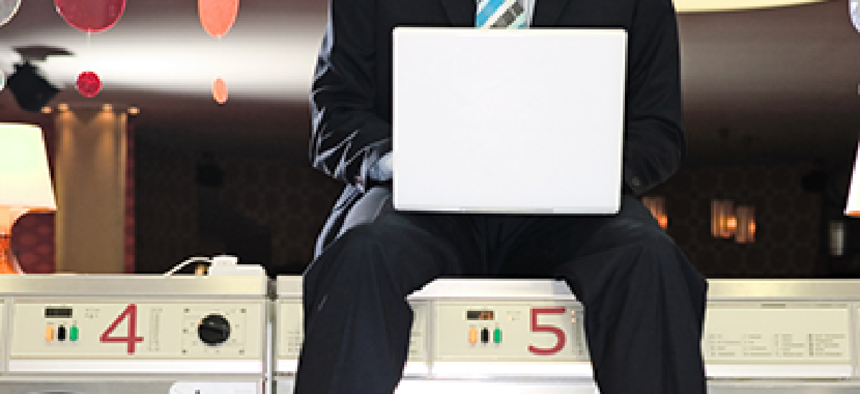What to make of USPTO's telework troubles

Amid the bad press and congressional inquiries, telework proponents stress that management, not location, is what matters.

The U.S. Patent and Trademark Office was a poster child for telework even before the Telework Enhancement Act was passed in 2010. In 2003, the agency was designated the Best Organization for Teleworkers by the Mid-Atlantic Telework Advisory Council after it launched its first work-at-home program in January of that year.
By fiscal 2013, 64 percent of USPTO employees were teleworking, saving 46 million commuting miles, $5.8 million dollars in gasoline and about 24,000 tons of greenhouse gas emissions a year, according to the Office of Personnel Management's 2013 Status of Telework in the Federal Government report to Congress. The report also found that the telework program was helping USPTO retain its "highly skilled workforce."
Then the Washington Post reported on USPTO teleworkers doing laundry and exercising during work hours, questionable productivity patterns among some patent examiners, and signs that agency officials were trying to hide the more embarrassing findings.
Now USPTO's telework program is a poster child of a different sort, with members of Congress demanding answers. House Oversight and Government Reform Committee Chairman Darrell Issa (R-Calif.) is launching an investigation and sent a letter to Commerce Secretary Penny Pritzker on Aug. 19 declaring, "It appears the telework program is not serving its intended purpose."
USPTO official declined to be interviewed for this story. But several management experts and telework proponents in the federal IT community told FCW that what happened at USPTO was not a telework problem at all. It was a management failure.
"The success of any organization -- whether employees work together physically in a central location or from remote locations -- depends on numerous factors unrelated to whether supervisors can physically see the employees," said Steve Shih, deputy associate director for executive resources and employee development at OPM.
Steve O'Keeffe, founder of the Mobile Work Exchange, was more direct. "It exposes some of the problems federal government has with management," he said. "It's not a problem because telework is different; it's about managing people."
Telework at federal agencies has surged since the Telework Enhancement Act. From 2011 to 2012, there was an 84 percent increase in the number of federal employees with telework agreements, according to Telework.gov.
"Telework is an important tool for achieving a resilient and results-oriented workforce," OPM's 2013 telework report states.
Despite the numerous benefits, not having employees within view is a challenge for managers who are more comfortable with the traditional office structure of seeing people at their desks.
"We're asking people to think about work in a totally different way," Shih said. "Most people in leadership positions grew up their whole lives watching the people around them get up and 'go to work.' Now work is [being] and can be done from literally anywhere thanks to mobile devices, remote technology and collaborative telework tools."
He added that the success of a telework program in any type of work environment largely depends on whether supervisors do a good job of planning and communicating expectations about employee performance and how that performance will be monitored, evaluated and rewarded.
"The fact that people are physically present is taken as a validation that they are on the job," O'Keeffe said. "Telework presents the opportunity to look at a more performance-based culture where people are measured on the quality of their outcomes as opposed to their presence."
One solution might be more frequent performance reviews. According to John Palguta, vice president for policy at the Partnership for Public Service, a review is not something that should happen only once a year. It should be an ongoing conversation between managers and employees who telework.
"Good managers have a sense of what they should expect at the end of the day from an employee, knowing whether an employee actually did something that day or read a novel at their desk," Palguta said. "Do I have something that tells me if they are earning their salary? Either I can do that or I can't. It doesn't matter if they're across the hall or in another state."
Management resistance is the No. 1 cultural challenge that exists with telework adoption, said Mika Cross, a workplace transformation strategist who is currently a presidential management fellow at OPM. She said telework should be seen as an opportunity to drive increased employee engagement.
"There is a difference between engagement and 'happiness' or morale, but there also is a definite correlation between the two," Cross said. "What we've seen with regard to the annual Federal Employee Viewpoint Survey scores is that agencies that rank higher often have a higher adoption of flexible work options, including telework."
The challenge also lies in realizing that telework isn't for everyone. The Telework Enhancement Act requires agencies to develop a telework policy, determine which employees are eligible, and inform and train those employees. It does not guarantee all employees the right to telework.
"Telework is a privilege, not an entitlement," Palguta said. "Recognizing that telework isn't for everyone may be one of the first steps."
And while Palguta and others agreed that USPTO's troubles do not reflect the state of telework in the federal government as a whole, they do serve as an important reminder: Technology can evolve only as far as management allows it to.
"Telework is a tool, and like any tool, you can use it build nice things or you can use it make a bigger mess faster," Palguta said.
NEXT STORY: What you missed at Lollachilipalooza


